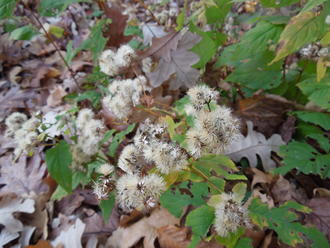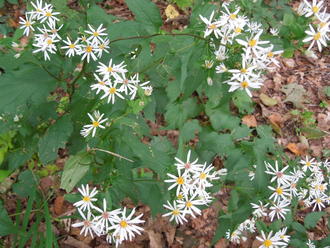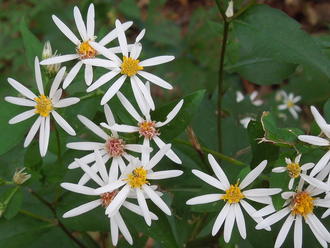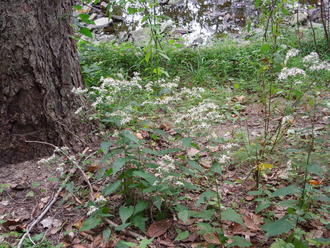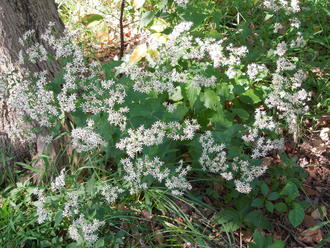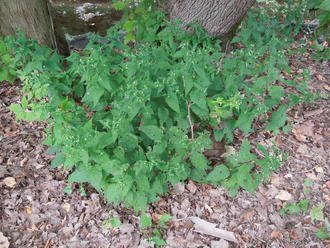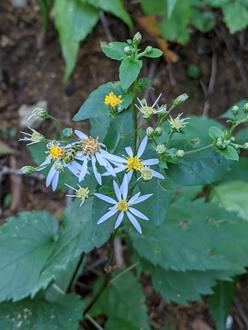White Wood Aster (Eurybia divaricata (L.) G.L. Nesom)
↑Summary
A shade-tolerant perennial native to and slightly beyond the Appalachians.
↑Habitat
Found in shady, mesic to dry sites in forests, especially on moderate slopes with rocky soils with abundant organic matter. Occurs both in deciduous and mixed deciduous-coniferous forests. Towards the open end of its habitat preferences, it is often found near the base of trees where soil is thinner and shade heavier. Although most common in upland forests, it is sometimes found on well-drained sites in bottomlands and riparian forests. Also found in anthropogenic habitats, including shady gardens, on the north faces of buildings or walls, and in narrow gaps between buildings.
This species requires significant shade and is absent from rock outcroppings, cliffs, or slopes steep enough that organic matter cannot accumulate and the forest canopy becomes too thin or open. It prefers slightly acidic soils, ideally rocky soils with thick leaf litter. Moderate slopes with relatively large (several inches wide) rocks interspersed with more developed soil are ideal as they allow the trapping of significant amounts of leaf litter and the holding of enough moisture to support closed-canopy forests.
Occasionally found in a variety of other soil conditions. Tolerates clay soils if the site is well-drained, rich loamy soils if there is not too much competition from other plants, and sandy soils if they are not too strongly acidic. Has a fairly strong preference for sloped terrain although it can occur on flat sites in otherwise ideal conditions. Most common in the Appalachians and becomes uncommon-to-rare in the coastal plain as well as flatter interior regions west of the Appalachians.
Tolerant of heavier shade than most asters. Usually found only in mid-to-late successional stages of forests, where it is often a dominant plant in the herbaceous layer. Its presence in earlier successional stages is likely limited by both the higher light levels and lack of leaf litter.
Thrives in high-quality natural areas but can also be found in disturbed and fragmented habitats. Tolerates and may even benefit from small-scale disturbance so long as shade and soil conditions are maintained. Its lower height relative to other herbaceous plants makes it more likely to escape weeding or trimming when growing in urban and suburban areas. In suburban gardens, it seeds into flower beds with other groundcovers, sometimes growing inconspicuously under dense shrubbery where it is also protected from weeding or mowing. It can grow in mulch beds, but is most competitive where poorer, rocky soil mixes with organic matter such as leaf litter or mulch, or where such organic material forms a thin layer over pavement.
Humans have reduced the habitat for this species by clearing forests and leaving forests in earlier successional stages where it is often absent, but we have also helped it by widely planting it in landscaping and creating spaces for it to thrive in anthropogenic habitats, which can aid its recolonization of forests when they regrow.
↑Life Cycle
This species is a slow-growing rhizomatous perennial.
Seeds typically germinate during warm weather between late spring and summer. Germination may be most likely following a small-scale disturbance. Seedlings grow slowly, often growing only an inch or less the first year. On small plants, the individual leaves also remain small, and may not reach their full size in the first year or perhaps even longer. First year plants usually do not bloom. Although all plants grow slowly, their growth rate depends on conditions and is slower in deeper shade or thinner, drier soil. Plants may take 2-5 years to reach their full height.
Once established, plants bloom from late summer to early fall, earlier than most asters. Flowers are insect-pollinated. Seeds are wind-dispersed, but often do not travel very far owing to being slightly heavier, on shorter stems, and the plant often growing in habitats where it is sheltered from wind. Seeds may germinate in the following spring, but can also form a persistent seed bank. Although this species has been recorded germinating from a soil seedbank in numerous studies, we could not find any sources establishing how long it persists in the seedbank.
Spreads by rhizomes to form large patches or colonies. New stems typically arise several inches from existing stems, but over time the plant can spread many feet. Commonly reproduces both vegetatively and by seed, often on the same site. The physical structure of this plant, with multiple stems, helps to trap leaf litter in autumn near the base of each plant, maintaining the conditions it likes.
Growth is more vigorous on richer sites, but this plant often becomes most dominant in slightly dry, shaded conditions with slightly rocky or acidic soil, because of less competition from other plants.
Competition with taller vegetation is poor, and this species usually only survives where factors such as heavy shade, rocky soil, or dry soil, which this species tolerates, prevent the establishment of other, more vigorous vegetation.
We could not find information on the lifespan of individuals in the wild, but they are likely very long-lived, possibly living for decades or longer.
↑Faunal Associations
The flowers support bees and butterflies. The seeds are eaten by birds and small mammals. The foliage is a preferred forage for white-tailed deer, and this species can be harmed by deer overbrowsing.
The larvae of at least three specialist lepidoptera eat this species: the pearl crescent (Phyciodes tharos) butterfly eats the foliage of this and other plants of the aster family, the moth Gnorimoschema gallaeasterella eats the foliage of this and other plants of the Astereae tribe of the aster family. It is also eaten by the Bucculatrix sexnotata moth, which may be more specialized on this species and other asters, including New York aster (Symphyotrichum novi-belgii).
↑Uses
Widely used as a landscaping plant, often as a groundcover. It is valued for its attractive leaves, flowers, and seedheads, as well as its tolerance of dry shade and its ability to bloom well in deeper shade than most late summer flowers. In landscaping, it can be grown on moister, richer, and sunnier sites than it would occur on in the wild, but it generally requires weeding to keep it from being shut-out by taller vegetation. On these sites, growth is usually faster than in the wild.
This species can also be used within its range in shaded portions of green roofs.
It has some use in restoration plantings, but is only competetive under a specific set of circumstances. It can be effective for seeding into an area with the shady, rocky soils and sloped terrain that it prefers, and can help stabilize and improve the soil on these sites. It competes poorly on sites able to support taller herbaceous vegetation.
↑Related Plants
Several other Eurybia species, all native to North America, overlap with this one in range, but this is the most common one in most locations where it occurs. The next most common are bigleaf aster (E. macrophylla), which has a more northerly distribution, and E. schreberi. There is a small amount of overlap with E. spectabilis.
↑Links & External Resources
• Eurybia divaricata (White Wood Aster) | USDA PLANTS Database (About This Site)
• Eurybia divaricata | Go Botany (About This Site)
• Eurybia divaricata (White Wood Aster) | Missouri Botanical Garden Plant Finder (About This Site)
• Eurybia divaricata | Biota of North America Project (BONAP) (About This Site)
• Eurybia divaricata | NatureServe Explorer (About This Site)
• Eurybia divaricata | Flora of North America (About This Site)
• White Wood Aster | Maryland Biodiversity Project (About This Site)
• Eurybia divaricata (L.) Nesom (White Wood Aster) | Digital Atlas of the Virginia Flora (About This Site)




